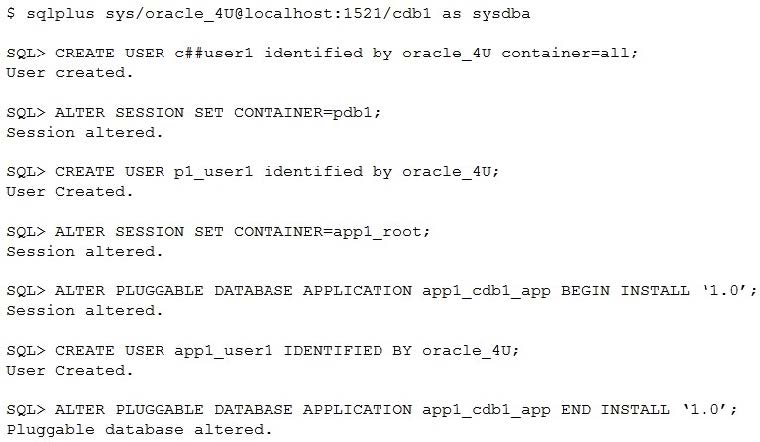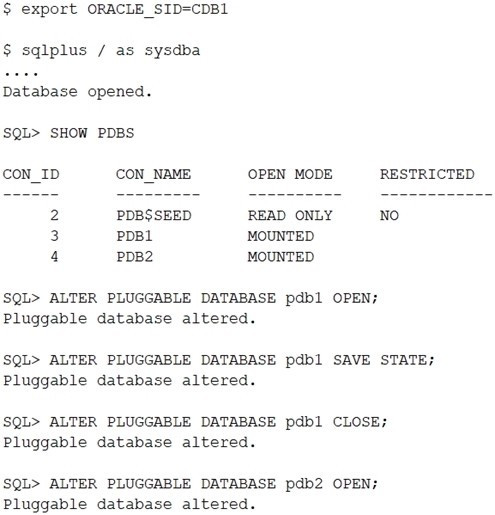1Z0-083 Online Practice Questions and Answers
While backing up to an SBT channel, you determine that the read phase of your compressed Recovery Manager (RMAN) incremental level 0 backup is a bottleneck.
FORCE LOGGING is enabled for the database.
Which two could improve read performance? (Choose two.)
A. Increase the size of tape I/O buffers.
B. Disable FORCE LOGGING for the database.
C. Increase the size of the database buffer cache.
D. Enable asynchronous disk I/O.
E. Increase the level of RMAN multiplexing.
For which two requirements can you use the USER_TABLESPACE clause with the CREATE PLUGGABLE DATABASE command? (Choose two.)
A. to specify a default tablespace in a PDB cloned from another PDB in the same CDB.
B. to exclude all tablespaces except SYSTEM, SYSAUX, and TEMP when plugging in a PDB
C. to include specific user tablespaces only when relocating a PDB
D. to specify the list of user tablespaces to include when moving a non-CDB to a PDB
E. to exclude a temp tablespace when plugging in a PDB
F. to specify the list of tablespaces to include when creating a PDB from the CDB seed
Which two are true about OS groups and users for Oracle Grid Infrastructure and the Oracle Relational Database Management System (RDBMS)? (Choose two.)
A. By default, members of the OSASM group can access Automatic Storage Management and RDBMS instances.
B. The primary group for the Oracle Grid Infrastructure and Oracle Database owners must be the Oracle Inventory group.
C. The Oracle Grid Infrastructure installation must be owned by the grid user.
D. The Oracle Grid Infrastructure owner owns Oracle Restart and Oracle Automatic Storage Management binaries.
E. The Oracle Grid Infrastructure owner must have OSOPER, OSBACKUPDBA, and OSKMDBA as secondary groups.
F. The same OSDBA group must be used for Automatic Storage Management and the Oracle Database.
Examine this configuration:
1.
CDB1 is a container database.
2.
COMMON_USER_PREFIX is C##.
3.
PDB1 is a pluggable database contained in CDB1.
4.
APP1_ROOT is an application container contained in CDB1.
5.
APP1_PDB1 is an application PDB contained in APP1_ROOT.
You execute these commands successfully:

Which two are true? (Choose two.)
A. APP1_USER1 can be created in PDB1.
B. APP1_USER1 can be created in CDB1.
C. APP1_USER1 can have different privileges in each Application PDB contained in APP1_ROOT.
D. C##_APP_USER1 can be created in CDB1.
E. P1_USER1 can be created in CDB1.
F. C##_USER1 will have the same privileges and roles granted in all PDBs in CDB1.
Which two are true about Oracle Database Configuration Assistant (DBCA) templates? (Choose two.)
A. The General Purpose of Transaction Processing templates are most suitable when concurrency and recoverability are key criteria.
B. Oracle DBCA templates can store only logical structure and not database files.
C. New templates can only be created by modifying an existing user-created template.
D. The Data Warehouse template is most suitable when transaction response time is the key criterion.
E. Oracle DBCA templates can be used to create new databases and duplicate existing databases.
Which two are true about creating RMAN backups for an Oracle container database? (Choose two.)
A. Tablespaces from different PDBs with identical names must be backed up by connecting RMAN separately to each PDB to back up the tablespaces.
B. The BACKUP DATABASE command will create a pluggable database (PDB) backup when RMAN is connected to a PDB.
C. SPFILE backups can be created while connected to an application root PDB.
D. The BACKUP DATABASE PLUS ARCHIVELOG command will back up archive logs when RMAN is connected to a PDB.
E. The BACKUP PLUGGABLE DATABASE command can be used to back up CDB$ROOT.
Which are the three steps in the SQL tuning process for Oracle Database environments? (Choose three).
A. Tune individual SQL statements using the SQL Tuning Advisor.
B. Identify poorly tuned SQL statements using Automatic Database Diagnostic Monitor.
C. Test the application as a whole using tuned SQL statements.
D. Test tuned SQL statements one at a time for all statements in the application.
E. Identify poorly tuned SQL statements using the SQL Tuning Advisor.
F. Tune SQL statements as a group using the SQL Tuning and SQL Access Advisors.
Which three statements are true about Automatic Workload Repository (AWR)?
A. All AWR tables belong to the SYSTEM schema.
B. The AWR data is stored in memory and in the database.
C. The snapshots collected by AWR are used by the self-tuning components in the database
D. AWR computes time model statistics based on time usage for activities, which are displayed in the v$SYS time model and V$SESS_TIME_MODEL views.
E. AWR contains system wide tracing and logging information.
You are working on an Oracle Database 19c database. You enabled the Flashback Database feature. Which two statements regarding flashback logs are true? (Choose two).)
A. Flashback logs are not archived.
B. Flashback logs are maintained in redo log files.
C. Flashback logs are maintained in the Flash Recovery Area.
D. Flashback logs are used to maintain Flashback Database related errors.
E. Flashback logs need to be cleared manually after you disable Flashback Database.
Which three RMAN persistent settings can be set explicitly? (Choose three)
A. SPFILE backup duplexing
B. control file auto backup formats
C. archive log deletion policy
D. image copy duplexing
E. redo log backup duplexing
F. archive log backup duplexing
In a recent Automatic Workload Repository (AWR) report for your database, you notice a high number of buffer busy waits. The database consists of locally managed tablespaces with free list managed segments. On further investigation, you f ind that buffer busy waits is caused by contention on data blocks. Which option would you consider first to decrease the wait event immediately?
A. Decreasing PCTUSED
B. Decreasing PCTFREE
C. Increasing the number of DBWN process
D. Using Automatic Segment Space Management (ASSM)
E. Increasing db_buffer_cache based on t he V$DB_CACHE_ADVICE recommendation
Examine the statements that use flashback technologies:
1.
FLASHBACK TABLE customers TO TIMESTAMP TO_TIMESTAMP (2013-02-04 09:30:00, YYYY-MM-DD HH:MI:SS);
2.
SELECT * FROM customers AS OF SCN 123456;
3.
FLASHBACK TABLE customers TO BEFORE DROP;
4.
FLASHBACK DATABASE TO TIMESTAMP TO_TIMESTAMP (2013-02-04 09:30:00, YYYY-MM-DD HH:MI:SS);
5.
SELECT * FROM customers VERSIONS BETWEEM SCN 123456 AND 123999;
6.
ALTER TABLE customer FLASHBACK ARCHIVE;
Which set of statements depends on the availability of relevant undo data in the undo tablespace?
A. 1,3,6
B. 1,2,5
C. 3,4,5
D. 2,3,5,6
PDB1 and PBD2 are pluggable databases in CDB1. Examine these commands:

CDB1 is then restarted.
Which three are true? (Choose three.)
A. PDB2 will be MOUNTED.
B. PDB1 will be MOUNTED.
C. PDB$SEED will be opened READ ONLY.
D. PDB2 will be opened READ WRITE.
E. PDB1 will be opened READ WRITE.
F. PDB$SEED will be MOUNTED.
Which three are true about using Database Upgrade Assistant (DBUA) to upgrade a database? (Choose three.)
A. The Pre-Upgrade Information Tool script is executed by DBUA.
B. DBUA must be launched from the target Oracle Home.
C. All pluggable databases are automatically upgraded as part of a container database upgrade.
D. A whole database backup must exist before upgrade
E. The database must be opened in read-only mode.
F. Multiple databases with the same ORACLE_HOME can be upgraded simultaneously.
Which three are true about creating container databases (CDBs) and pluggable databases (PDBs) in Oracle 19c and later releases? (Choose three.)
A. A PDB snapshot can be a sparse copy of a source PDB.
B. A PDB snapshot depends on an existing storage snapshot of the source PDB.
C. A CDB can be duplicated using Recovery Manager (RMAN) with no configuration required before starting the duplication.
D. A CDB can be duplicated using the Database Configuration Assistant (DBCA) in silent mode with no configuration required before starting the duplication.
E. A PDB snapshot can be a full copy of a source PDB.
F. A snapshot copy PDB can be a full copy of a source PDB.
G. A snapshot copy PDB does not depend on an existing storage snapshot of the source PDB.
